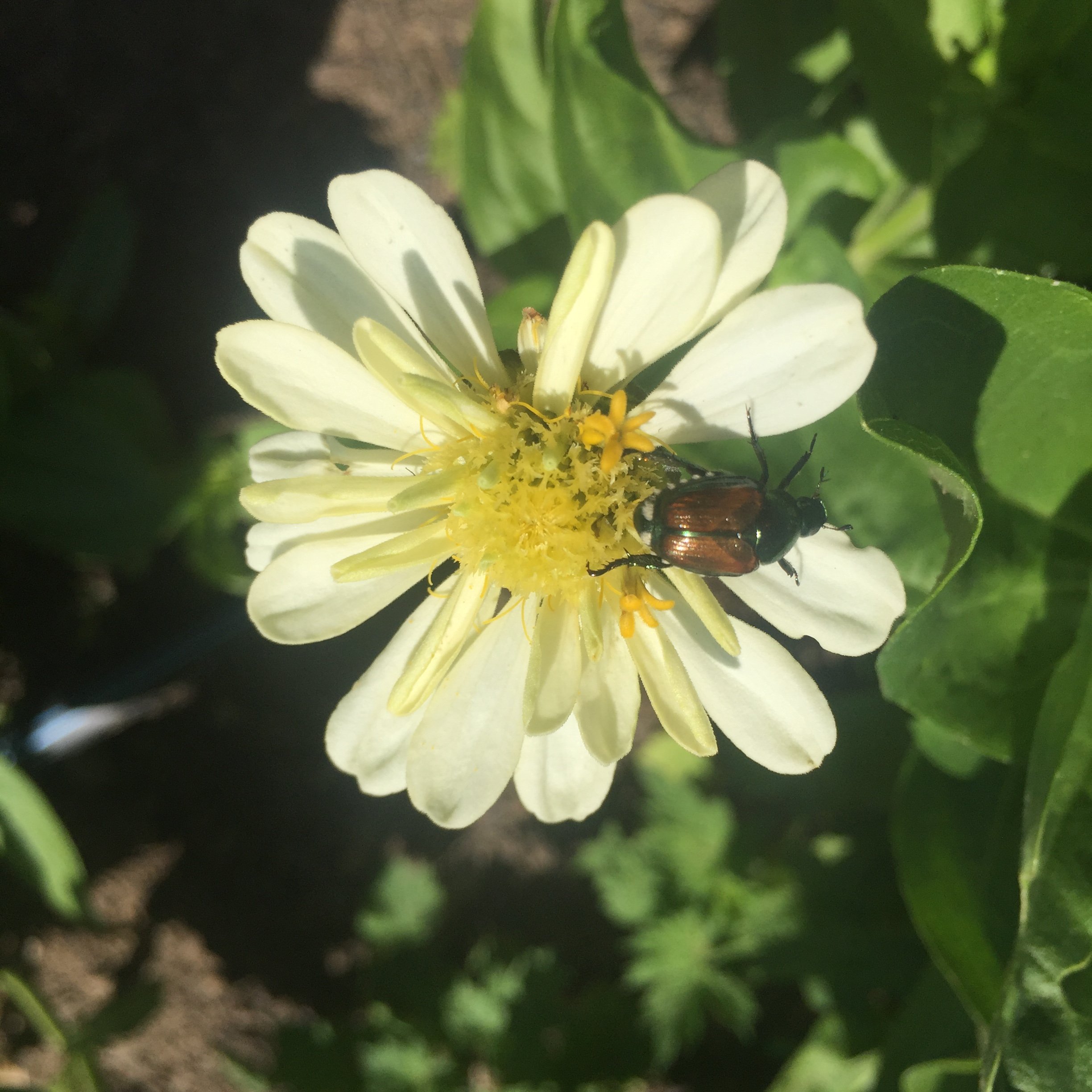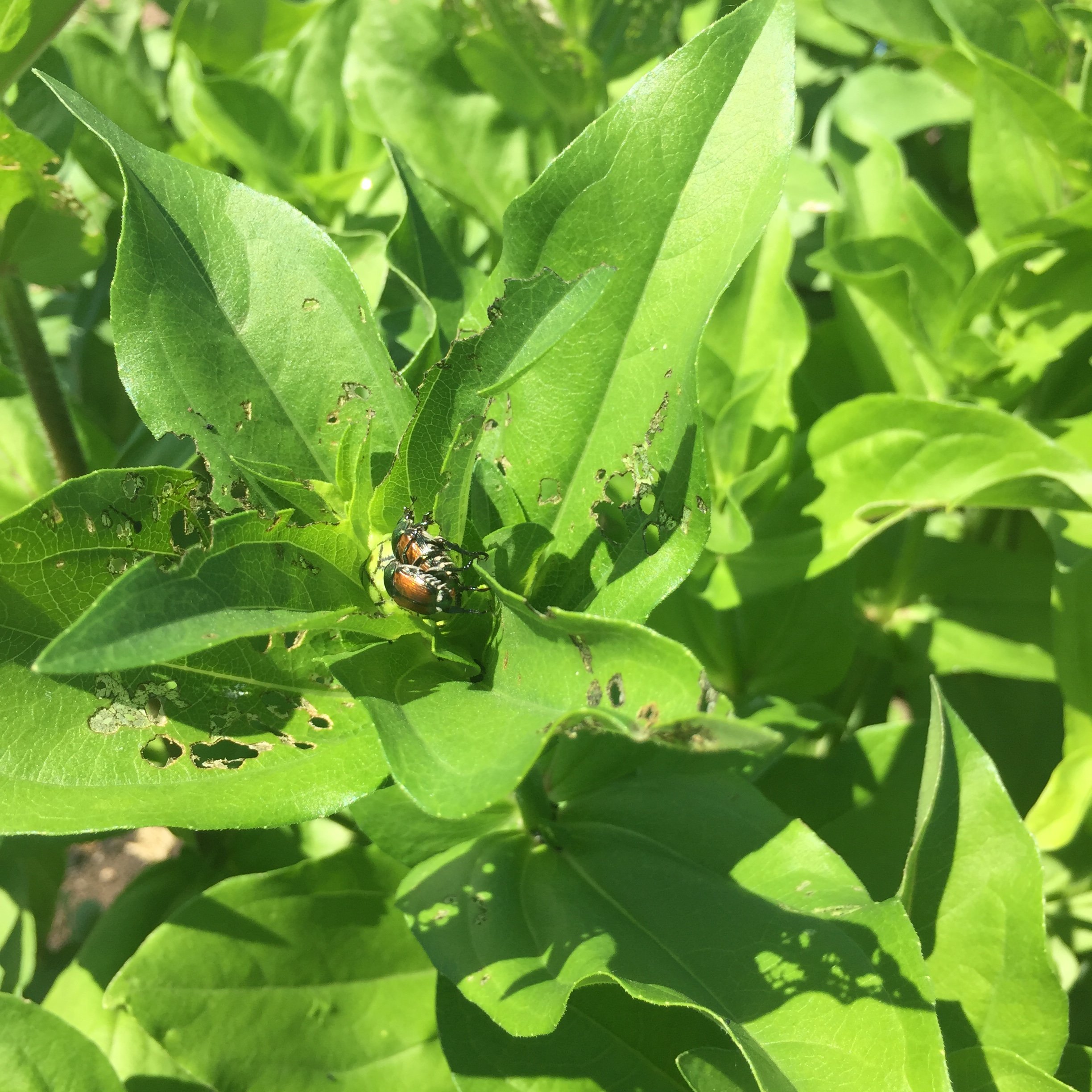How to Get Rid of Japanese Beetles Naturally
July 10, 2023
July is officially the beginning of Japanese Beetle season in our Zone 6 climate. This time of year (at least in the Northeast and Midwest parts of the United States) the big, iridescent black Japanese Beetles come of age and feast on garden plants. Japanese beetles are voracious and feed constantly. It can really drive you mad when your gorgeous flower garden gets munched to bits.
how to get rid of Japanese Beetles without using chemicals
On our 1-acre flower farm, we grow over an acre of specialty cut flowers and foliage in Western New York Zone 6b. Since we started growing cut flowers in 2018, every year seems to be different for the Japanese Beetles. I chalk this up entirely to the climate — specifically, the type of winter we have the season prior — to how intense the Japanese Beetle populations are.
Some years have been so light on Japanese Beetles that we haven’t bothered to do any control. Other years, the beetles have been so bad it required natural intervention.
Related: VIDEO Presentation: Regenerative IPM for the Flower Farm
Japanese Beetle damage on zinnia plant, also Japanese Beetles getting down n’ dirty.
Why we don’t like pheromone traps for japanese beetles
First, I’d like to briefly discuss my experience with using pheromone traps for Japanese Beetle control. I do not like using hormone/pheromone traps because they actually attract more beetles to the garden than before. The logical response to that is, “well then why don’t you place it far enough away from the garden?” but the beetles need to travel a distance to get to the traps and become interested in other plant material on their way there. It seems, if a Japanese Beetle has a choice between a pheromone trap and one of its favorite tasty plants, it will always choose the favorite tasty plant. The hormone traps just don’t work well enough for my liking.
hand pick japanese beetles for ultimate control
If you have the time, and your space isn’t too large, handpicking Japanese Beetles off of your garden plants is the best way to control them. Once the Japanese Beetle is dead, it’s dead, and will not be coming back. Japanese Beetles produce only one generation per year, which is why hand picking is so effective.
What is hand picking? Hand picking insects means dealing with the insects one by one — whether that’s literally picking them off plants with your hands, or, like you’ll see below, knocking them into a trap.
Most Popular: The Reasons Why Synthetic Fertilizers like Miracle-Gro Are So Bad for Your Garden
Japanese Beetles hang out on undersides of plants, too.
How to hand pick japanese beetles
The least “gross” and effective way to hand pick Japanese Beetles is to actually knock them into a bucket of soapy water and let them drown. Here, a small bucket of soapy water acts as a 100% natural Japanese Beetle trap. You have to be very quick about knocking them into the bucket because they will sense your presence and fly away. Rather than squishing Japanese Beetles one by one, by knocking them into a bucket you can knock multiple in at a time.
How do you knock Japanese Beetles into a bucket? By shaking the plant, or even smacking the plant, above the bucket. Some Japanese Beetles will save themselves by flying away and some will meet their demise. It’s a process you’ll need to repeat multiple times per day until the beetles are gone (and they may never entirely be gone). If you are able to spend time and be diligent with this task, it will work well for you.
To dispose of the dead Japanese Beetles, I simply throw them in the compost pile, soapy water and all. We use Dr. Bronner’s Castile Soap which is entirely chemical-free.
Blurry photo of Japanese Beetles drowning in a coffee can of soapy water.
The best way to get rid of japanese beetles
Here is where I’m really going to blow your mind with some amazing gardening wisdom. The easiest way to deal with Japanese Beetles is to first always assume they are going to be present, then plant some of their favorite things so they eat that instead of everything else in your garden. Then stand back and do nothing. Truthfully, you’re not “getting rid of” the Japanese Beetles at all, rather, encouraging them to feed on something you don’t care about.
Related: Why is Tilling So Bad?
Using plants in your garden to control specific bugs is what we call Trap Cropping. Trap Cropping can be done for a myriad of other insects, and even rodents and larger mammals like gophers and deer. To Trap Crop successfully, you must know what the insect really loves to eat. What is it they will decimate completely in your garden over everything else?
Trap crops for japanese beetles
In my first year of flower farming, I planted tons of Echinacea purpurea ‘Magnus’ and ‘White Swan’ in my flower field for cut flower production. When growing cut flowers, it is uber imperative that there is zero bug damage on the petals. Cut flowers have to be perfect or near perfect to sell. I was discouraged when Japanese Beetles flocked to the field that summer and munched the petals of my Echinacea to the point that the entire crop was unsellable. What a waste!
Related: Flowers We’re No Longer Growing, Part 2
On the contrary, I learned an invaluable lesson from that lost crop of Echinacea when I dug it up the following year. I decided to remove the Echinacea and make room for a different crop that wouldn’t be completely eaten by Japanese Beetles. That year, with the lack of Echinacea in the field, the Japanese Beetles moved onto their second favorite crop in the field: Zinnias, apparently. They ate to their hearts’ content on the Zinnia patch and again, I was forlorn.
Valuable Lesson Learned: Echinacea purpurea is a trap crop for Japanese Beetles.
With this information, I am planting multiple patches of Echinacea within my annual fields at our new flower farm in hopes this will help control future populations of Japanese Beetles. The Echinacea is a sacrificial crop — I do not expect to harvest flowers from these patches, and any that I do is a win.
Echinacea patch before it was decimated by Japanese Beetles.
japanese beetles love invasive grapevine
That same year the Zinnia crop was munched on, I decided to go into the field with a bucket of soapy water and attempt to handpick the Japanese Beetles off my beloved Zinnia flower crop. As I was knocking the stems, some Beetles flew away and landed on wild invasive grapevine that started growing along my fence. Then they literally never left. Japanese Beetles loved that grapevine so much that they all eventually flocked to it, and I realized I had my very own natural Japanese Beetle trap. Ever since then, I have not had to control Japanese Beetles. This is simply because they prefer the invasive grapevine over the 70+ other crops in the field.
Related: How to Start a Sheet Mulch Garden
Disclaimer: Invasive grapevine is not a plant you want growing in your yard, on your farm, or anywhere for that matter. Do not plant it if you do not have one. This is advice only for those who already have wild invasive grapevine on their properties.
overplant what japanese beetles love
Another way to deal with Japanese Beetle damage, without having to handpick them, is to just overplant the things you know they love to eat, if it’s something you love, too. “Overplanting” means planting more than you need. This is an easy, obvious strategy for farmers growing on a large scale.
To farm sustainably, organically, regeneratively (whatever term you want to use), we must accept that bugs live here too.
Let’s repeat that. Bugs live here too! Japanese Beetles, invasive and harmful or not, live here too. If we use chemicals, even OMRI-approved insecticides/pesticides, we are introducing toxins into our ecosystems that negatively impact ALL OTHER SPECIES, including the bugs we really do want and need in the garden (bees, butterflies, ladybugs, hoverflies, lacewings, etc).
In this age, it is imperative we accept the creatures that live around us and learn to live in harmony with them. This includes adopting our own levels of tolerance to these creatures, whether you think they’re gross or not. We cannot be good gardeners and earth tenders if we go around killing everything that lives in it.
peace, love, and mindful cropping,
fran parrish






